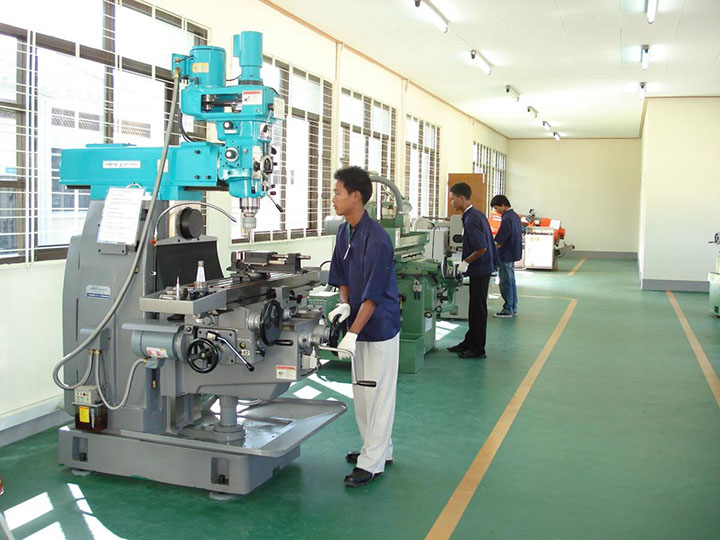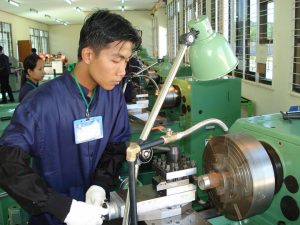Myanmar, like many other countries around the world, is facing the challenge of youth unemployment /underemployment. “Youth” is defined in the “Myanmar Labour Force, Child Labour and School-to Work Transition Survey, 2015 (Executive Summary Report) January to March 2015,” as being persons of age 15 to 29. The Youth population in Myanmar was estimated in 2015 to be at 12.1 million, that is 26% of the total population. The figures will not have changed much at the present time.
The major proportion of youths, particularly in the rural areas, are unemployed or largely underemployed as unpaid family workers . For the future development of the country and lower youths unemployment/underemployed it is incumbent to train them to acquire employable skills. Young people have to be able to enter in jobs in the different economic sectors, as they become available with the increasing investment in the many sectors now being witnessed.
Relevant data regarding education attainment and employment of youth from the Report published by the Department Labour, the Ministry of Labour, Immigration and Population and the International Labour Organization (ILO) is presented below.
“Education Attainment of total working population”,(aged 15 and above):- At the national level, 12.2% are “Not literate”; 18.7% are “Below Primary”; 34.1% are “Primary”; 21.4% are “Middle”; 0.2% are “Vocational Certificate”; 6.5% are “High School”; 1,1% are “Undergraduate Diploma”; and 5,8% are “Bachelor Degree and above”.
“Educational status of Youth,” (age 15 to 29):- At the national level, 5.5% are ”Not Literate”; 13.9% are “Below Primary”; 32.8% are “Primary”;30.3% are ”Middle”; 0.4% are “Vocational Certificate”; 9% are “High School ”; 2.4% are “Under Graduate Diploma”; 5.8% are “Bachelor degree and above”.
According to the Report, out of the total working age population of age 15 upwards a total of 86.4% are of education attainment below High School . Also 77.4% of youth are “Literate below High School”.
Youths also form the bulk of so called “general worker” in the cities and towns including the Industrial Zones. Many of them work as “helpers” of experienced skilled workers in an occupation and go on, through work experience and “Non-Formal” or “Informal” means to acquire knowledge and skills of their occupation. The report acknowledges that “Training outside the formal education system plays an important role in improving the employability of a person”.

In the past “Formal” Vocational Training at the skilled worker level, could only be accessed by those who complete at least “Middle School”. Fortunately the new education law makes it possible for those who complete “Primary School” to access such training. So with the implementation of the present law, those with only primary level education who took up jobs in the past as “Helpers”/”Learners” in Industrial Establishments could now have the opportunity to undergo occupational skills training (and certification) in the formal education sector prior to entering an occupation.
Nowadays most young persons are not interested in undergoing lengthy periods of training (considering not only the time but also the cost involved) to earn a “Certificate” in a broad range of related occupations . There are of course many young persons who complete High School and take the vocational training courses at “Certificate” level with the intention of continuing through, while working and if situation permits, to the Diploma Level Courses and beyond.
The occupational skills training courses for the youths completing primary school should however, as far as possible, be short and occupation oriented according to the occupation and level of competency required for meeting the emerging skills needs of all the economic sectors.
Occupational Competency Standards (OCS) for over 25 common occupations at the Semi-skilled; Skilled; Advance Skilled and Supervisory levels have been drawn up, on a priority basis, by the National Skills Standards Authority (NSSA) formed by the Ministry of Labour, Immigration and Population, under the 2013 Employment and Skills Development Law. Assessment and Certification of occupational competency in line with the occupational competency standards, is being carried out for workers applying for recognition of their acquired skills.
Occupational Competency Standards Based Training could be costly as the “practice” period should be adequate and involve utilization of the required training resources, particularly consumable training materials, for the attainment of competencies as per the standard on which the training is based. Hence budget provisions for such training have to be adequate.
Training of youths for occupational skills development should be conducted, as far as possible, based on the Occupational Competency Standards, for more closely meeting the needs of the employers in the various economic sectors.-By Lokethar



